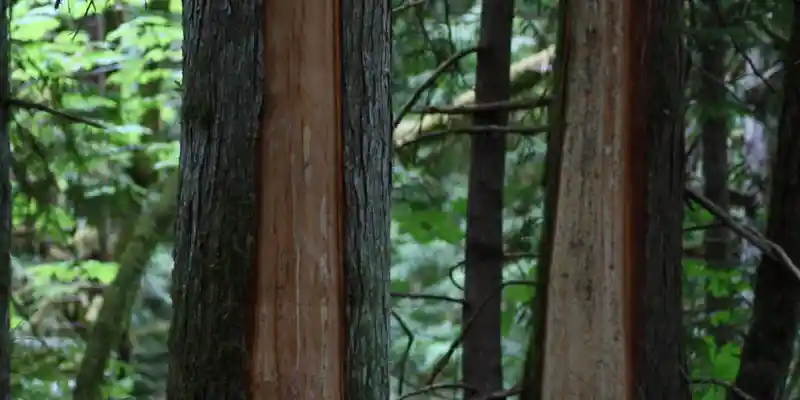Vancouver, British Columbia — In January 1997, Thomas Grant Hadwin, 49, Canadian forest engineer, cut down the Golden Spruce, a landmark tree in British Columbia's Queen Charlotte Islands, as a protest against the logging industry.
While facing criminal charges, he disappeared en route to his trial.
Born in 1948 in West Vancouver, Hadwin's family was active in the logging industry. Hadwin himself became a logger and later became a logging engineer. However, he became increasingly upset with the logging industry's methods and exhibited signs of mental instability. In January 1997, he went to the Queen Charlotte Islands and purchased a chainsaw.
Early on the morning of January 20, 1997, he made a series of deep cuts in the Golden Spruce, a Sitka Spruce tree located on the Haida Gwaii archipelago and considered sacred by the Haida people (Indigenous people who traditionally occupy the coastal bays and inlets of Haida Gwaii). The tree fell two days later.
Photo on the bottom, shows the sacred trees on Haida Gwaii, carefully and respectfully stripped of bark for making hats, baskets, masks or mats. The area is nicknamed Canada's Galapagos for its diverse plant and animal life, and the totem pole and longhouse remains are some of the oldest authentic examples of coastal First Nations villages.The Queen Charlotte Islands were officially renamed Haida Gwaii in December 2009 as part of an historic reconciliation agreement between the Haida Nation and the province of British Columbia. Haida Gwaii was created as an alternative name for the islands to acknowledge the history of the Haida Nation. The name Haida Gwaii translates as "islands of the people" in the Haida language.

After cutting down the tree, Grant Hadwin left the islands. He sent a fax to the media and the Haida nation claiming responsibility for the act, saying that he was motivated by "rage and hatred towards university trained professionals and their extremist supporters..." The act outraged people throughout Canada and received extensive media coverage. Hadwin was arrested, ordered to return to the islands to stand trial, and released on bail.
Hadwin's court appearance was scheduled for February 18, 1997, in Masset, British Columbia. Many people speculated that he would be killed before he could stand trial. Hadwin said that he feared for his safety if he were to travel by ferry or plane; he decided to make the trip across Hecate Strait by kayak instead. On February 11, he set out from Prince Rupert, British Columbia, but turned back a day later after being caught in a storm. On February 13, he set out again. The next day, he was spotted north of Prince Rupert, but then mysteriously disappeared. He failed to appear in court as scheduled. There have been no confirmed sightings of him since then.
In June 1997, Hadwin's empty kayak and most of his gear were found on an uninhabited island northwest of Prince Rupert. Because he was known to be an expert in wilderness survival, many believe that he faked his own death and vanished into the wilderness. However, because the winter weather was rough and Hadwin had made many enemies, many believe he may have drowned or been murdered.
His ultimate fate remains unknown.











Comments